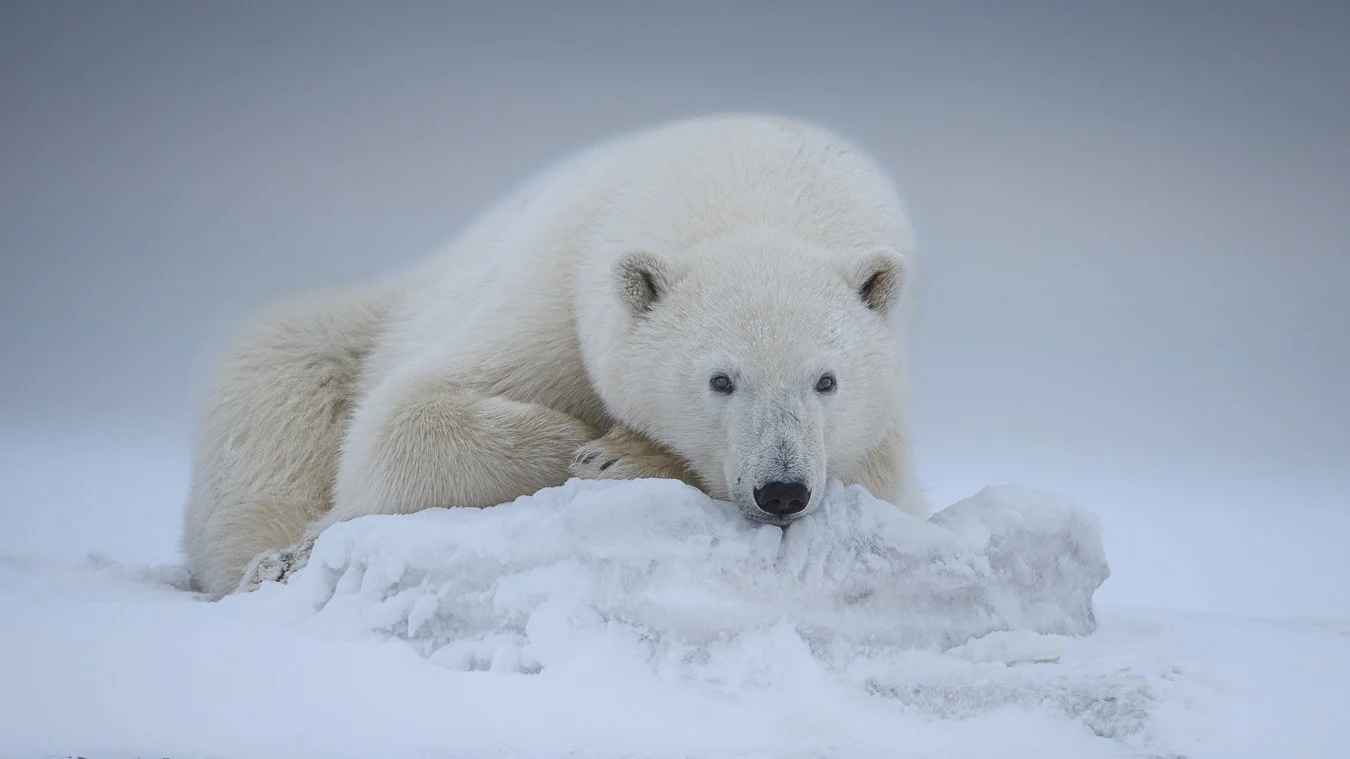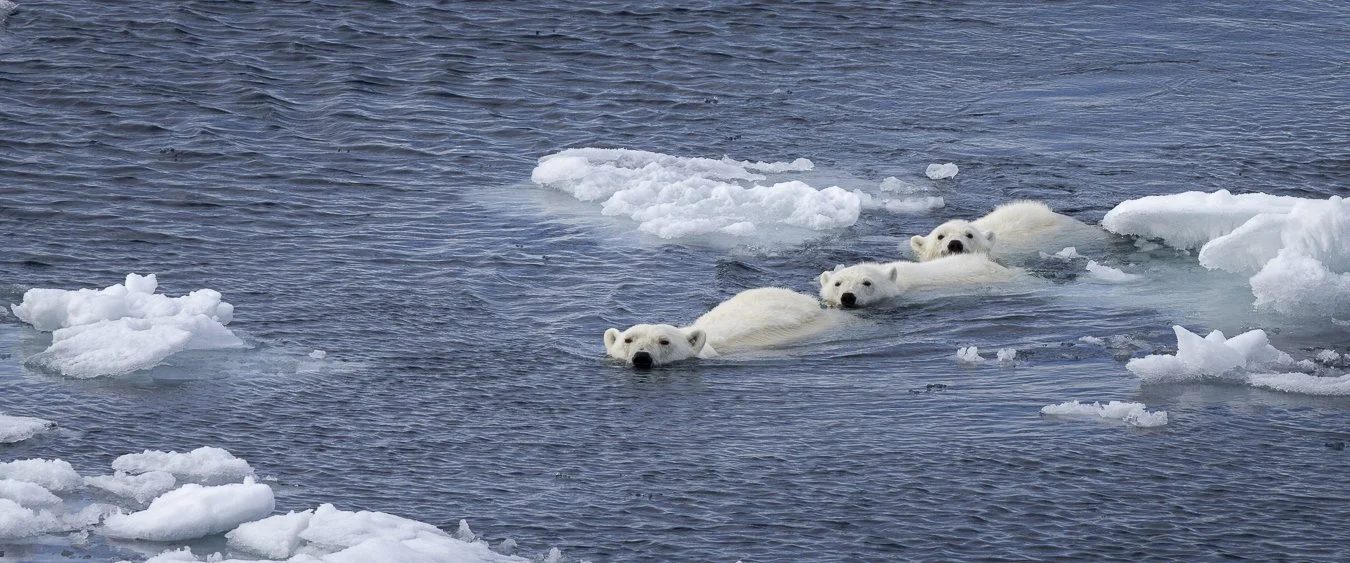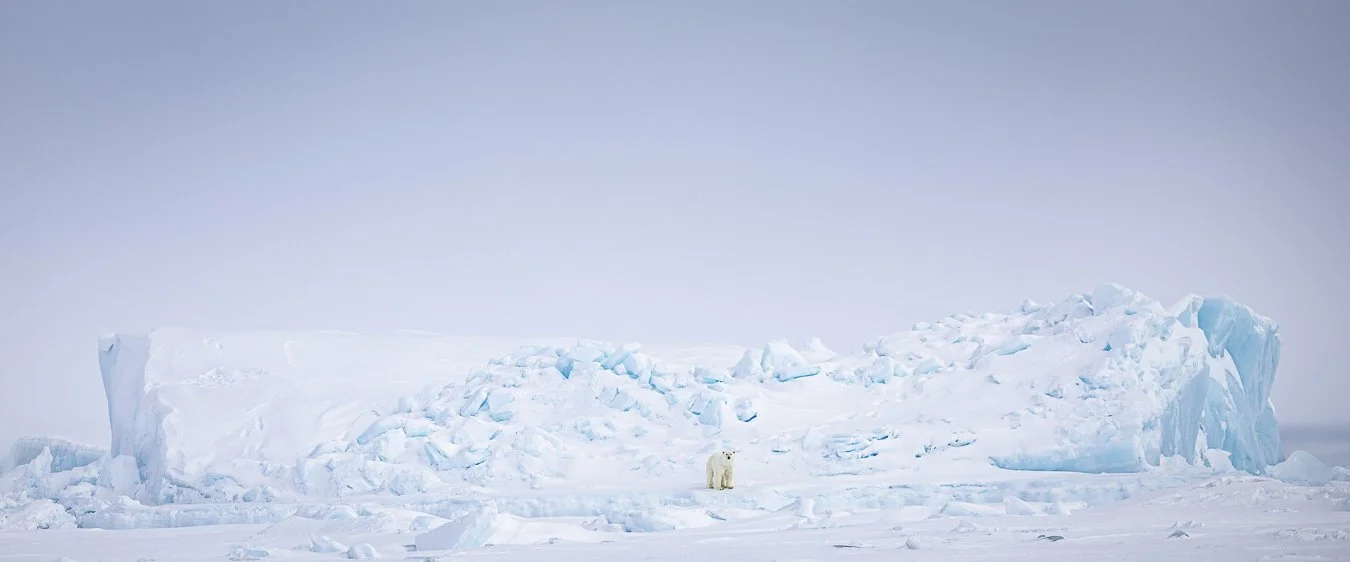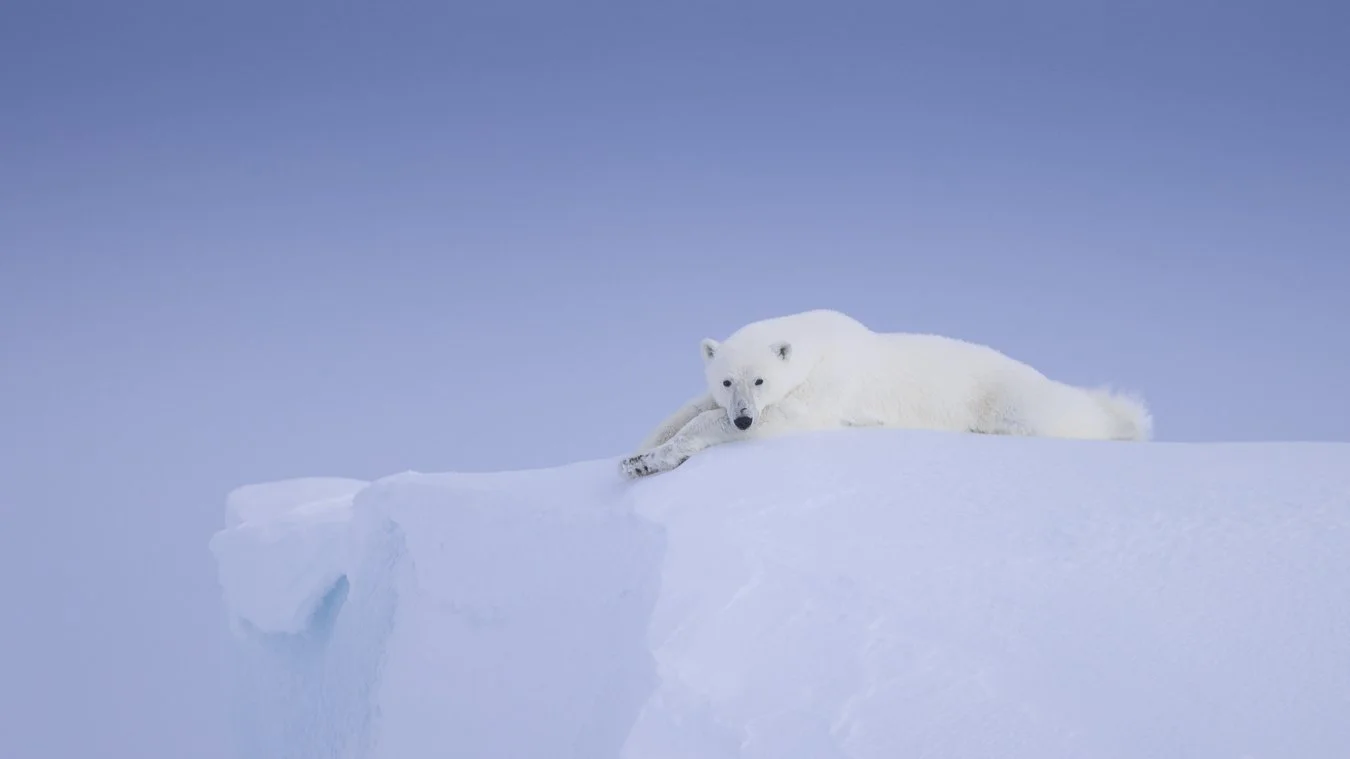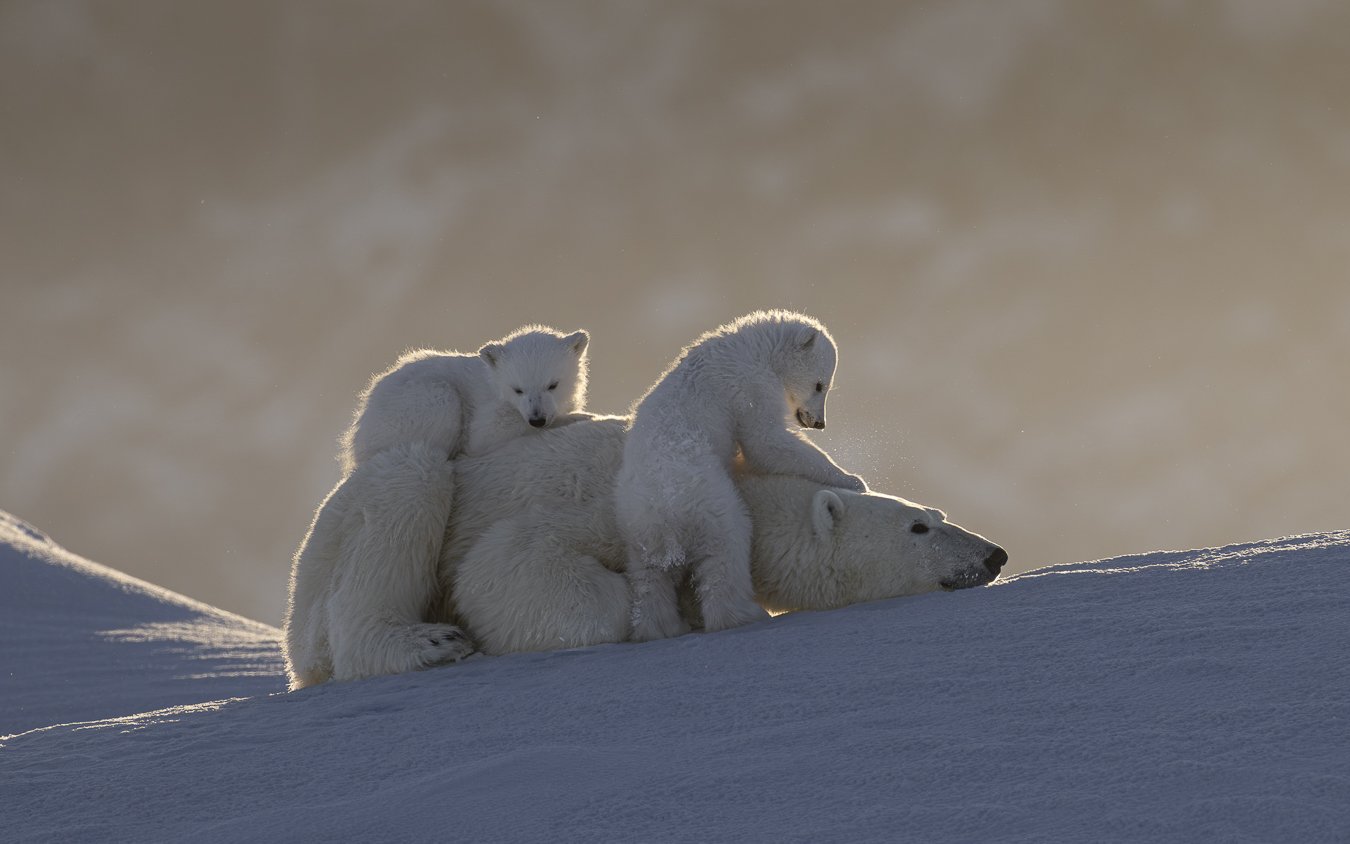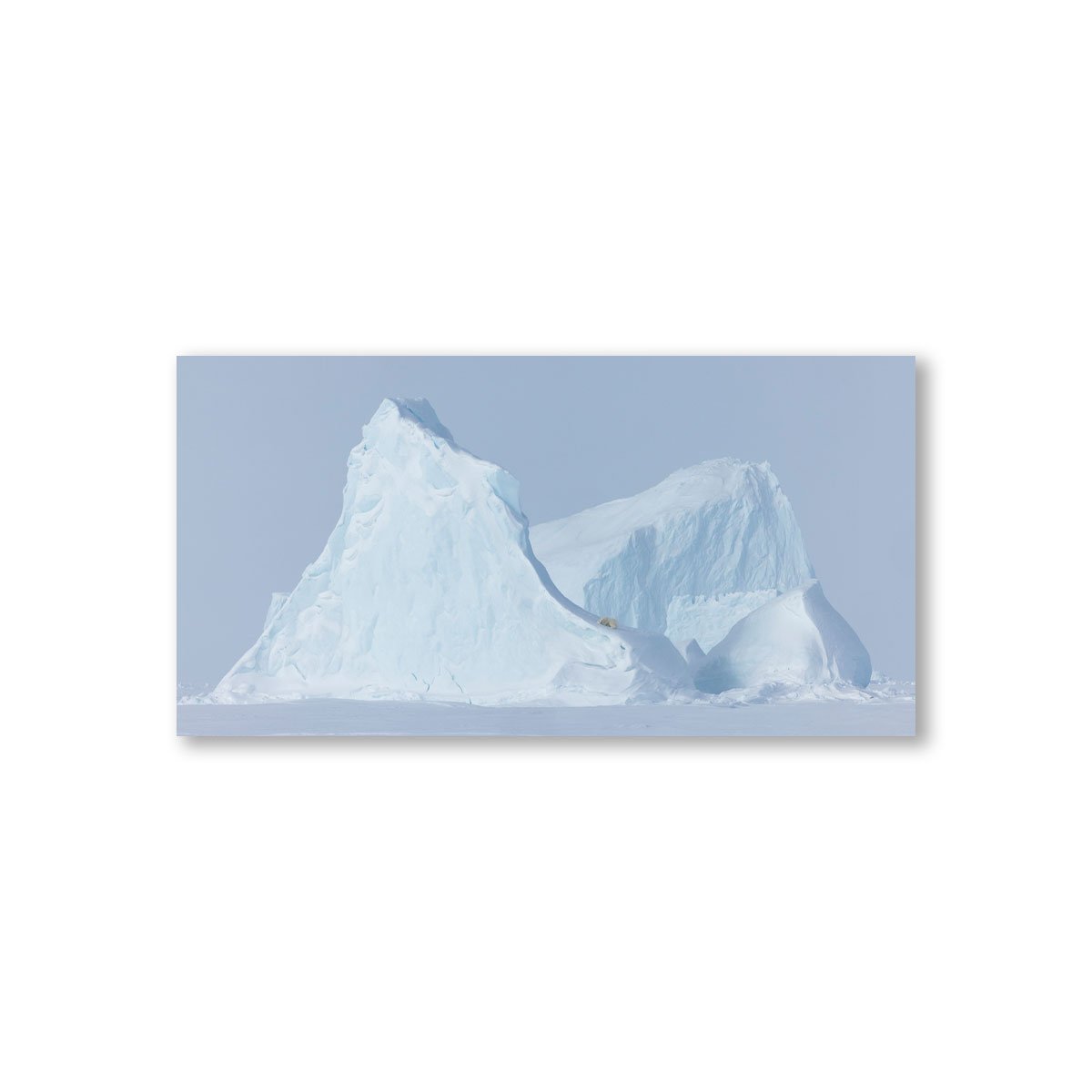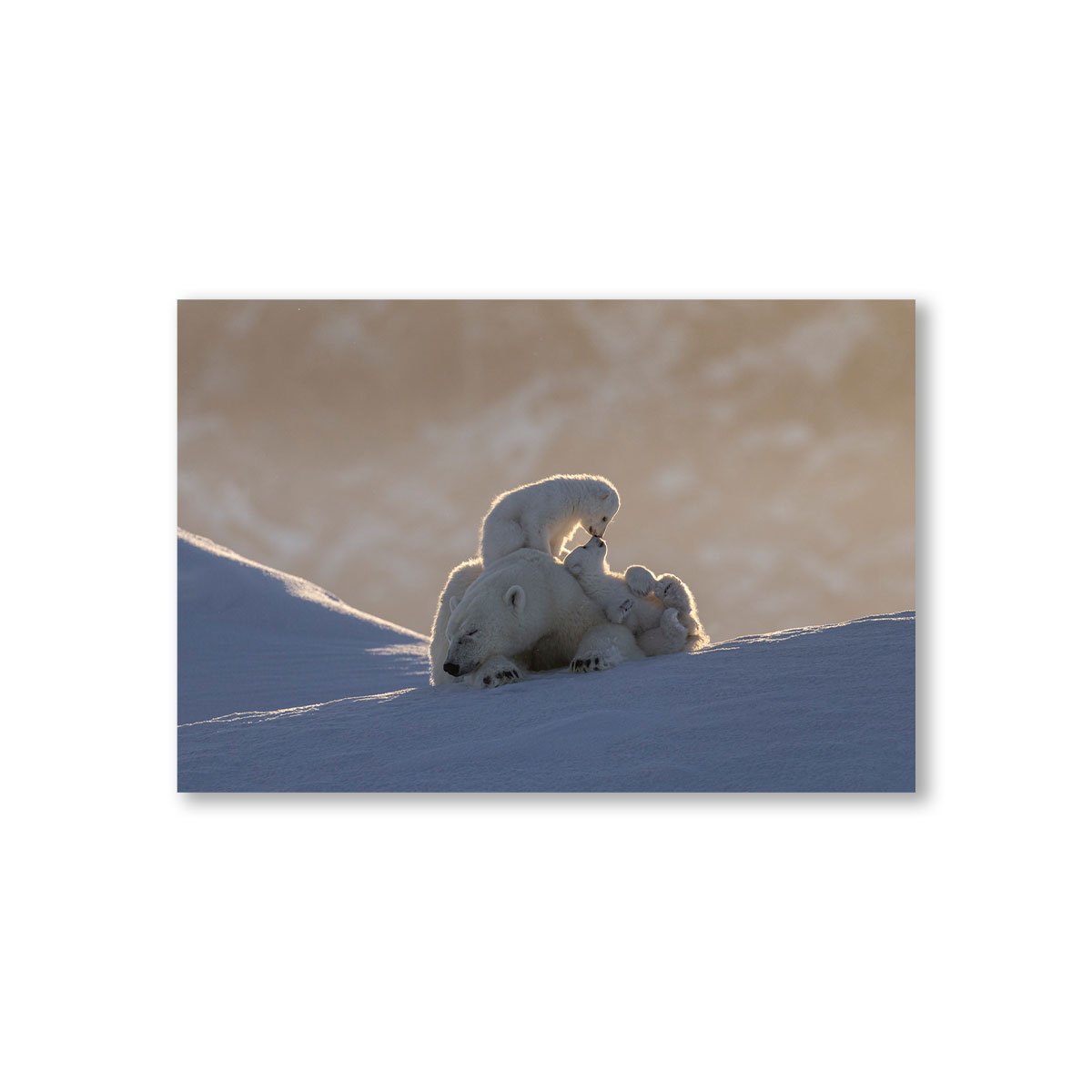POLAR BEAR PHOTOGRAPHY-CAPTURING BEAUTY, RESILIENCE AND ARCTIC MAJESTY
Picture of Polar Bear resting on ice
A Polar Bear Photographer’s Journey
Ever since I saw my first polar bear in Svalbard in 2009, I’ve been captivated. That moment launched a deep passion that has taken me on seven polar bear photography expeditions across the Arctic. From the frozen fjords of Norway to the icy lagoons of Alaska and the remote sea ice of Canada, I’ve chased the perfect image of one of Earth’s most awe-inspiring predators.
To capture compelling polar bear pictures, I’ve endured hostile environments. We’re talking about regions where the air can freeze your skin in seconds, land of the midnight sun or where the sun doesn’t rise for months. In such an extreme world, it is astonishing that polar bears not only survive but thrive. That’s why I find polar bear photography is such a powerful challenge and privilege.
This blog dives into what I’ve learned through my camera as a polar bear photographer, highlighting some of the best locations for photographing polar bears, what makes them special, and why capturing these moments matters.
Polar Bear framed against towering glacier
Svalbard – The Arctic’s Crown Jewel
Svalbard, a remote Arctic archipelago in Norway, is one of the most visually stunning environments on the planet. With its glistening glaciers, towering cliffs, and dramatic fjords, it’s a dream destination for landscape and wildlife photographers alike.
Over the last decade, I’ve visited Svalbard three times, each trip full of potential but also unpredictability. On one expedition, we had just a single good sighting over ten days. It can be incredibly frustrating. Despite the pristine backdrops and the presence of other unique Arctic wildlife such as walrus, Arctic foxes, reindeer, and seabird, getting close to polar bears is not guaranteed.
One of the challenges of polar bear photography in Svalbard is that sightings often happen from the deck of an ice-class expedition ship. That means you’re typically photographing the bears from above, which lacks the emotional engagement of an eye-level image. Getting low is essential to create intimacy and drama in polar bear pictures.
Picture of Polar Bear mother and cubs swimming
To add to this, new Norwegian regulations now require ships to maintain a minimum 500-meter distance from polar bears between March 1 and June 30. Even if a curious bear approaches an anchored vessel, ships are legally required to move away. These rules, although rooted in good intentions, have made close encounters rarer and polar bear photography more challenging. Tour operators and photographers that have argued that these new rules are overly restrictive and that tourists do not pose a significant threat to polar bears. However, the rules are there, and it will be interesting to see what impact there will be on tourism numbers in this season and beyond.
Despite the obstacles, other polar bear photographers like Paul Goldstein, Ole Jørgen Liodden, Piet Van Den Bemd, and Danny Green have captured breathtaking polar bear images here. It can be done but requires patience, luck, and expert guidance.
However, my frustration that I wasn’t getting the images of Polar Bears that I had in my mind led me to look at other places to photograph Polar Bears. After doing an Alaska expedition with Carl Donohue and his company Expedition Alaska, he told me about Kaktovik, a place where he had led Polar Bear expeditions for a few years. His polar bear pictures blew my mind. They were exactly what I was looking for- engaging and eye catching.
Picture of polar cub walking on the ice
Kaktovik – America’s Polar Bear Capital
Kaktovik, a small Inupiat village located on Barter Island in the Arctic National Wildlife Refuge, became famous in the early 2000s due to its "whale boneyard," where bowhead whale remains attract polar bears each autumn. When the lagoon remains ice-free, small boats are permitted to ferry photographers out into the shallow waters for up-close encounters.
I visited in 2013 and again in 2014. The first trip was magical with freezing conditions, dramatic snowy settings, and daily sightings of polar bear mothers and cubs. We could shoot from a fishing boat getting low and close. These conditions are what every polar bear photographer dreams of.
The second year wasn’t as kind. The lagoon froze unexpectedly early, and we had to shoot from land vehicles, limiting angles and proximity. That’s the gamble with Arctic wildlife photography: nature is in control.
Unfortunately, Kaktovik has been closed to non-essential travel since the COVID-19 pandemic, and permits for polar bear boat viewing have not resumed. If that changes, I would return with Carl in a hearbeat.
Polar bear mother and cub huddling together
Baffin Island – A Polar Bear Photographer’s Paradise
When I first booked a trip to Baffin Island through Paul Goldstein, I thought it would be a once-in-a-lifetime adventure. Now, after three expeditions, I know I’ll return, hopefully in 2027. It’s hard to describe the feeling of photographing polar bears on foot, in a sea of endless ice and towering icebergs dotted about the landscape and never in the same position year after year.
Paul works closely with Arctic Kingdom who amongst several photography expeditions run a seasonal polar bear photography camp on the sea ice. The set up is extraordinary. In the vast Canadian arctic camp is set up 3 hours away from the nearest village Qikiqtarjuaq- known as Qik. The camp is set up on the sea ice for 6 weeks, before having to pack up as the sea ice is starting to met. To get to Qik requires precise planning and luck. Reaching the camp is no small feat: it involves multiple flights, weather delays, and logistical coordination. But it’s worth every ounce of effort. Each year there has been travel issues getting to Qik, but this is where Arctic Kingdom are a world class operator in dealing with logistical issues. I can’t speak highly enough about them and urge anyone reading to check them out.
Polar bear mother and cubs peek above the ice
It’s fair to say that on my first photography expedition I wasn’t as prepared for the freezing temperatures as I should have been, despite lots of preparation. Keeping my hands warm were a constant challenge. So when we were told to get ready after a three-hour skidoo ride, mostly blind as googles had frozen, that a polar bear mother and cubs had been spotted, I could barely operate the camera. I have never known pain like it as my fingers succumbed to the frozen temperatures.
However, the exhilaration from seeing polar cubs less than a week out of then den was worth any pain. That encounter which lasted 30 minutes or so was a precurser to an amazing day with the same mother and cubs who were resting on a stunning iceberg less than 30 minutes from camp.
To be on foot 100 metres from a polar bear is such a unique, emotional and magical experience. You have a glimpse into their world which is a privilege I don’t take lightly.
Polar bear cub hitches a ride on mothers back
One of the primary reasons for repeatedly going back to Baffin is because of the photographic opportunities it offers, especially with mothers and polar bear cubs. I have already shared an encounter that I will never forget in my blog – Polar Bears of Canada. That culminated in my award winning image “Age of Innocence”. Few things in wildlife photography compare to seeing polar bear cubs. Tiny, curious, and vulnerable it’s a magical and emotional experience being in their presence and watching their interactions.
Polar bear cubs touching while mother sleeps
Indigenous Arctic peoples, who have lived alongside polar bears for thousands of years, hold deep respect for the bear’s maternal power. In Inuit stories, the nanuk is both a fierce hunter and a devoted mother, qualities seen as worthy of admiration and emulation.
Polar Bear mother and cubs resting on iceberg
Equally impressive are the Polar Bear Kings and earlier this year we had several sightings of young polar bear males. Some were very tolerant of our presence and would watch us intently as we changed our positions at regular intervals to photograph them. The portraits and environmental shots I captured during our expedition now sit among my favorite work.
Male Polar bear framed against iceberg
A Baffin Island photography expedition doesn’t come cheap but for a once in a lifetime experience to photograph polar bears on foot in the most magnificent of Arctic environments, there is nowhere quite like it in my opinion. It stirs the soul and imagination and I feel so privileged to have had this unique photography experience.
Male Polar bear resting on tip of iceberg
Gear and Tips for Polar Bear Photography
As a polar bear photographer, preparation is everything. Here are some tips to help you succeed:
Use long lenses: Most of my images were shot on a 600mm F4 lens, often with extender to help you photograph from a safe distance.
Shoot wide when possible: To showcase polar bears in their Arctic habitat, a 70–200mm or 24–70mm can be powerful.
Eye-level matters: Always strive for lower angles to create a more emotional connection.
Keep your batteries warm: Arctic temperatures can drain power rapidly. Keep spares in inner pockets.
Layer wisely: Arctic expeditions can mean -30°C or lower. Use moisture-wicking base layers, down insulation, and windproof outer layers. I swear by Canada Goose and Icebreaker layers.
Polar bear walking with icy breath
Post-Processing Tips for Polar Bear Pictures
Capturing a great shot is only half the job. Post-processing is key to making your images shine:
Preserve natural colors: Arctic light can be harsh or flat; careful white balance is essential.
Sharpen selectively: Apply detail where needed, especially in fur and eyes.
Crop thoughtfully: Maintain context whenever possible to showcase the bear’s environment.
The Future of Polar Bear Photography
Climate change is transforming the Arctic. Sea ice is shrinking, and polar bears are forced to travel farther and fast longer. Photographers now document not just beauty, but a way of life under threat.
That’s why I support Polar Bears International through my print sales, who work tirelessly to support polar bear research and conservation. Do check out their mission and work if you are interested in learning more.
Polar bear cubs try and play with mum
FINAL THOUGHTS
To be a polar bear photographer is to embrace the cold, the unknown, and the wild. Through polar bear photography, we tell stories of resilience, motherhood, and survival.
For me, every frozen morning with cold hands and every click of the shutter has been worth it. I feel incredibly fortunate to witness these Arctic Giants in their world and through my polar bear pictures, I hope to share their beauty and resilience in a changing landscape.
I really hope that these images inspire you, as they have me, to protect and preserve one of nature’s greatest treasures: the polar bear.
Thank you for taking the time to read this blog . If you are interested in knowing more let me know your questions via this link or connect with me on Instagram — I love hearing from fellow polar bear lovers! If you also like any of these images check out my Print Shop.
Jules

